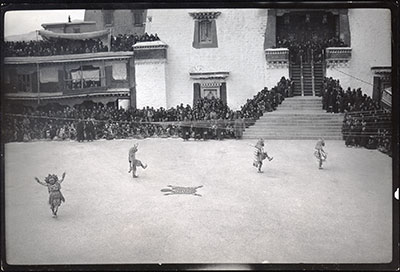
1998.131.616.3 (Print black & white)


1998.131.616.3 (Print black & white)

Frederick Spencer Chapman
Frederick Spencer Chapman
February 10th 1937
Lhasa > Potala > Deyang shar
1998.131.616.3
131 x 193
Dancing
Print gelatin silver
Donated 1994
Mrs Faith Spencer Chapman
British Diplomatic Mission to Lhasa 1936-37
Frederick Spencer Chapman
C.2 [view film roll]
SC.T.2.616
Notes on print/mount - The back of the print is covered in crop marks and reproduction instructions. The reference 'OC 2' has been written on the back of the print in pencil [MS 04/04/2006]
Manual Catalogues - Caption in Chapman's hand-written list of negatives made whilst on the Mission to Lhasa, 1936-7 [See PRM Manuscripts Collection]: '1/2 4 Skeletons in S. dance’; PRM Manuscripts Collection: ‘List of Tibetan Prints and Negatives’ - Book 3: ‘5/4 - The skeleton dancers perform round a mock ‘corpse’. They move to a rapid movement and mop and moan and clatter their bony fingers’ [MS 06/04/2006]
Other Information - Images prefixed with 'C' comprise a group of negatives containing images of and around the Potala and dancers at the Potala taken on February 10th 1937 [MS 04/04/2006]
Other Information - Description: "When the last of these pairs [of masked dancers] has retired the crowd suddenly begins to whistle. This is the traditional reception for the skeleton dance. Four skeleton dancers with two attendant death's heads appear on the stairs, mopping and mowing and scattering ashes to right and left from their clattering bony fingers. They dance round the crude representation of a corpse which has been laid in the middle of the dancing space. Light relief is provided by the figure of an aged man with a long grey beard who totters round the court playing the fool and finally has a tremendous struggle with a tiger skin rug. This part of the performance, incidentally, is an innovation of the late Dalai Lama, who dreamt this scene when he was in China" ['Lhasa Mission, 1936: Diary of Events', Part XIV p.2 , written by Richardson] [MS 06/04/2006]
Other Information - Setting: The “Tse Gutor” masked dances being performed by monks in the eastern courtyard of the Potala. This ceremony takes place at the end of the Tibetan calendar and is designed to purge the sins of the past year. At the Potala it is performed by the monks of Namgye Tratsang who undergo training for many years. Richardson gives a detailed account of this event in “Ceremonies of the Lhasa Year”: “The chief is the Chinese priest Hashang, a huge heavily padded figure in a scarlet robe and with a massive, smiling bald-headed mask. With him are two tiny child-like figures, two more in the dress of Indian sadhus, and two with death’s head masks” (1993:116 – 123) Then two more masked dancers arrive - one representing Shinje the lord of the dead and protector of the Buddhist faith and the other, the stag-headed Tsamuntri. Other dancers portray wrathful protector deities such as Dorje Jigje (with a bull’s head), Tamdrin (the horse-headed), a red masked Mahakala and the black-faced Lhamo. [CH 2003]
Other Information - Location: This photograph seems to have been taken from the balcony directly above the entrance to the eastern courtyard. The Mission had been offered use of the balcony above this one but, as this was better for photographic purposes, Gould apparently allowed the Chinese delegation to use the higher level. Chapman and Doctor Morgan were in charge of photography on this occasion and Chapman comments that he set up seven cameras (presumably a combination of cine and still) to record the proceedings [see ['Lhasa: The Holy City', F. Spencer Chapman, London: Chatto & Windus, 1938, p. 301] [MS 06/04/2006]
For Citation use:
The Tibet Album.
"Skeleton dancers at Tse Gutor"
05 Dec. 2006. The Pitt Rivers Museum.
<http://tibet.prm.ox.ac.uk/photo_1998.131.616.3.html>.
For more information about photographic usage or to order prints, please visit the The Pitt Rivers Museum.
© The Pitt Rivers Museum